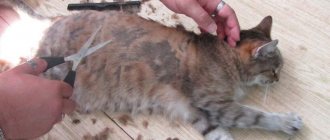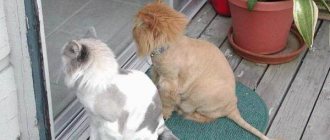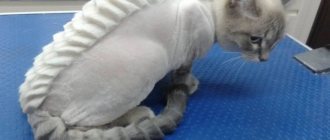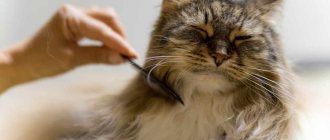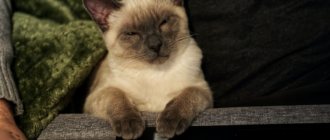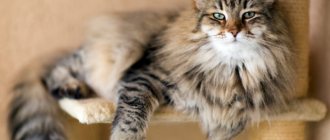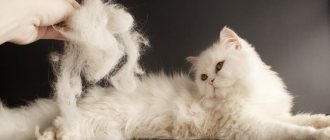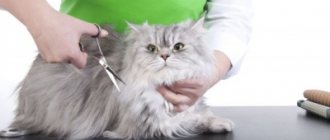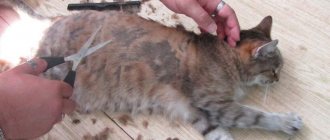Cats living in an apartment need full care. They need to be kept clean, fed properly, and their coats maintained in good condition. Moreover, many breeds require periodic shortening, and it is not always possible to carry out such a procedure at the veterinarian. In this case, you can use a special technique that teaches how to cut a cat’s hair at home.
Reasons and frequency of haircuts
Cats need to be trimmed from time to time for several reasons. Most often, this activity should be carried out with animals that have long hair, due to its constant rolling into clumps, which cause numerous inconveniences. Cat haircuts can have different purposes:
- For hygiene purposes. In this case, the process is necessary due to the wool becoming tangled and matted. The animal may get too dirty, and the type of contamination will be paint products or certain building materials that cannot be removed with shampoo.
- In certain situations, the fur of very old or sick cats that are unable to take care of their “fur coat” is shortened. This procedure prevents the formation of hair balls in the stomach, which often cause intestinal blockage. It is also necessary in conditions of elevated air temperatures, when there is a risk of overheating of the pet.
- Due to prolonged molting. In this case, cutting will make keeping the animal much easier.
- For medicinal purposes. For certain diseases of cats, haircutting may be recommended by a veterinarian. Indications for such a procedure are usually infectious skin diseases, dermatitis, the appearance of various parasites, as well as hyperplasia of the sebaceous glands. Trimmed wool makes it possible to treat the skin with medications more effectively, and this significantly shortens the treatment process.
- Decorative haircuts. Such hairdressing services for pets are nothing more than a whim of their owners. With the help of a model haircut, owners try to emphasize the individuality of their pet and the characteristics of its character.
- Exhibition haircuts are designed to demonstrate the standards of their breed in animals.
The frequency of procedures associated with shortening hair depends on the intensity of its regrowth. This usually takes from three to six months, depending on the breed of the pet, its health condition and age. On average, it is recommended to provide cats with such hairdressing services no more than two or three times a year.
Removal of tangles should be carried out as they appear.
Model haircuts can be performed more often, but in this case the health of the animal, the condition of its coat, and the season of the year should be taken into account. Therapeutic and hygienic haircuts are usually carried out as needed.
Application
An aqueous solution of formaldehyde (methanediol) stabilized with methanol - formalin - causes denaturation of proteins, so it is used as a tanning agent in the tanning industry and tanning gelatin in the production of film. Due to its strong tanning effect, formaldehyde is also a strong antiseptic; this property of formaldehyde is used in medicine (Formidron, Formagel and similar preparations) and for the preservation of biological materials (the creation of anatomical and other preparations).
Formaldehyde is used as a fumigation agent, in particular during the storage and transportation of grain.
An aqueous solution of formaldehyde (methanediol) stabilized with urea - KFK - is one of the most important sources of formaldehyde and urea in the production of urea-formaldehyde, melamine-urea-formaldehyde resins and for the treatment of urea against caking; used in the woodworking and furniture industries for the production of plywood, chipboard, etc.
The main part of formaldehyde is used in the production of thermoset polymers (phenol-formaldehyde, urea-formaldehyde and melamine-formaldehyde resins); it is also widely used in industrial organic synthesis (pentaerythritol, trimethylolpropane, etc.).
During storage (at temperatures below 9 ° C), the formaldehyde solution becomes cloudy and a white precipitate (paraformaldehyde) precipitates.
Registered in the food industry under code E240.
Main nuances
Cat owners should be aware that not all animals can have their fur trimmed. The restrictions may be influenced by the following factors:
- Color-point or typing type of color. In this case, the regrown hair on the belly and back will be darker in color than before the haircut.
- Unbearable character and increased activity, when the pet cannot be brought into a calm state. In such a situation, you can use anesthesia, but first you need to take into account all the possible risks. Narcotic drugs can cause cardiac arrest, put you into a coma, and contribute to the failure of the kidneys and liver. If there is no other solution, anesthesia can be replaced with sedatives or muscle relaxants. But such an idea must be approved by a veterinarian, and drugs must be administered strictly under his guidance.
- It is not recommended to cut short-haired cats unless absolutely necessary, since in the heat their vital functions are not disrupted and tangles never form. Grooming of such breeds is only relevant in extreme situations, for example, if the animal is soiled with oil paint.
When planning to cut your cat's hair, you should be aware that the structure of its fur, length and color may change, and the regrowth process usually takes several months. It is forbidden to cut the hair on the animal's head, on the pads of the paws and in the inside of the ears.
Adviсe
Before deciding to groom your cat, you need to take into account the recommendations of experienced professionals. Thus, professional groomers advise, if possible, not to touch the tail, which is the most vulnerable part of the animal’s body.
Even minor damage to it causes enormous suffering to the pet and can negatively affect the cat’s overall well-being. You should also pay attention to the stomach, especially the lower, most tender part.
The next point that experts advise you to pay attention to is the psychological preparation of your pet. This procedure may require some time and patience from the cat owner.
So, long before the planned haircut, you need to start accustoming the animal to the table. This should be done very carefully and consistently.
To begin with, simply place the cat on the work surface, stroke its sides and back and, if possible, try to lay the pet on its side without stopping stroking. After the animal stops behaving warily on the table and responds happily to caresses, they carefully begin combing, each time increasing the time of the procedure.
If you are consistent and do not forget to regularly brush your cat on the table, then over time she will get used to the procedures and will perceive both the table and the comb quite calmly. The next important step will be to accustom your pet to the sound of a running machine. Ideally, it is better to purchase a silent device, but if this is not possible, then you can try to accustom the cat to the noise of a running electric motor. To do this, a few days before the haircut, you should turn on the clipper for a short time, while holding the pet in your arms and stroking it.
In general, grooming a cat should be perceived as an extremely last resort when the animal’s fur is hopelessly neglected and it is not possible to comb out the tangles. As for haircuts for decorative purposes, in this case it is necessary to be guided by the cat’s reaction to the procedure, while assessing the possible consequences. When performing complex show hairstyles, it is recommended to give the cat a rest and trim it in 2-3 stages.
It should also be remembered that a trimmed mustache, as well as hair inside the ears and on the head, significantly reduces the sensitivity of the smell receptors. There is no need to groom overly aggressive or overly active pets yourself. It is better to take such animals to an experienced groomer, where sedatives may be required. Thus, each owner must decide for himself whether to cut his pet’s hair or not. To do this, you need to soberly assess the benefit/harm ratio and focus primarily on the well-being and mental balance of your pet.
To learn why cats need to be groomed, watch the following video.
Recommendations from experts
The procedure for grooming domestic cats is a last resort; as a rule, it is resorted to due to the systematic formation of mats or the need for treatment based on medical indications. In most cases, animals with long hair undergo a similar process.
To prevent pets from getting tangled, it is recommended to comb them with special devices: a slicker brush and a furminator. In addition, animals need to be washed using high-quality products that help maintain the well-groomed condition of their “fur coat”. Such actions not only have a beneficial effect on the health of animals, but also relieve their owners from scraps of fur scattered throughout the house.
You should know that if someone in your household is allergic to a pet’s fur, cutting the pet’s fur will not help. This is explained by the fact that in this case the reaction of the immune system is caused directly by the skin secretions of the animal, as well as by its saliva preserved on the hair.
The coat of cats belonging to semi-longhaired breeds not only protects them from the cold, but also prevents overheating. This type is not inclined to form tangles and only needs regular bathing and combing. This applies to species such as Maine Coon, Norwegian and Siberian cats.
Persian breeds have thin and delicate fur, which after shearing is restored much easier than that of their counterparts. Persians have a very difficult time withstanding hot weather , so their coat is often shortened.
Features of grooming
It is impossible to carry out such a procedure on your own and get an effective result without the help of an assistant. Before cutting, in addition to the necessary equipment, it is recommended to purchase a collar for the animal, specially designed to protect against its bites. In addition, it is worth stocking up on compounds that have disinfecting properties, for example, chlorhexidine or hydrogen peroxide. They may be needed in case of possible cuts.
Required Tools
Since cat fur is thick and fine in structure, using scissors and clippers on people would be impractical. To provide hairdressing services to animals, you should prepare specialized tools directly for grooming. Such a set should include:
How often to cut, including depending on the breed
The frequency of haircuts depends on the rate of hair growth, the age of the cat, and its health. It is recommended to cut your hair 2-3 times a year, not more often.
| Cause | Explanation |
| Hygiene | Long-haired cats get dirty very quickly, their fur rolls into lumps, and when licking, the likelihood of swallowing it is high, which can lead to problems with the digestive tract. |
| Shedding | Reducing the amount of wool on furniture. |
| Skin diseases (infections, parasites, hyperplasia of the sebaceous glands, dermatitis) | With short hair, a cat is easier to handle. |
| Exclusive view | Only for the purpose of participating in exhibitions. |
For Persians, a haircut is an ideal option, especially in the summer, as they quickly grow overgrown, and they also do not like heat.
What breeds of cats are prohibited from being cut?
- Shorthair (British, Scottish Fold). There is no particular point, only when absolutely necessary. Please note that there are long-haired types of these cats, namely British Longhair and Highland Fold, they need to be cut.
- With tipping or color-point color. After a haircut, the pet's color changes (becomes darker).
- Semi-long-haired breeds (Siberian and Norwegian forest cats, Maine Coon) do not need a haircut; you can only limit yourself to bathing and thorough combing. Their fur serves as an excellent protector from overheating and freezing. Also read how to properly bathe a cat and how to brush it on the Mister Cat portal.
In addition, you should not generally trim hyperactive pets, which are difficult to pacify and require the use of sedatives, which have a negative effect later.
Why cut a cat's hair?
The need for a haircut is determined by the owner. You can do without it, but you need to regularly take care of your body, comb it, preventing the formation of tangles. More often they affect Persian cats, whose hair structure is soft and its length reaches up to 10 cm.
Tangles that are close to the skin are very dangerous. This provokes inflammation of the integument, sometimes insects and parasites lay eggs under them. Therefore, long-haired cats need to be trimmed more often. Indications for hygienic trimming and shaving are:
- The neglected state of the cat's hair is matted, covered with tangles, and difficult to comb. This prevents the access of air, which provokes the development of inflammation and skin tightness. The animal begins to gnaw out the tangles and swallows them. Bald spots and covering injuries form on the body.
- Heat - to avoid overheating.
- When the cover gets dirty quickly, it rolls up in clumps. They cause inconvenience and cause pain when the hair is pulled.
- To make caring for a sick or old cat easier.
- The pile is stained with indelible materials (paint and varnish, polyurethane foam, adhesive solutions, fuel oil). When dirty lumps of lint enter the stomach during licking, this can cause gastrointestinal problems and poisoning.
- In long-haired animals, the hairs in the perineum and under the tail are cut to prevent excrement from sticking.
- Prolonged shedding.
- Family members have severe allergies.
Indications for medicinal purposes:
- severe damage by parasites - lice, fleas;
- preoperative preparation;
- dermatitis;
- infectious skin pathologies;
- high activity of the paraanal and sebaceous glands;
- the need to treat the skin with medications.
Decorative hairstyles and shaving are done for a photo shoot. To do this, choose fashionable haircuts. More often they are done before exhibitions and competitions.
Groomers have differing opinions about semi-longhaired cats. Their pile has a two-layer structure with an air gap. If it is disrupted, thermoregulation is disrupted. However, some veterinarians believe that these cats need to be shaved periodically to keep the coat renewed.
How to cut a cat's hair: types of haircuts
| Type of haircut | Description |
| Exhibition (Harlequin, Continental, Modern) |
Haircut Continental
Choosing Cat Grooming Tools
The haircut can be carried out using scissors (medium size, sharp with rounded ends) or a clipper, preferably silent, so as not to frighten the pet. The latter method is more effective and safer - there is practically no possibility of injuring the animal, and the result is guaranteed: a uniform haircut with the ability to choose the desired length of fur.
- soft comb;
- textile;
- hydrogen peroxide or chlorhexidine (needed if you injure an animal);
- toys and treats;
- table (or other surface).
It is better to immobilize the cat during the procedure. For example, wear a special collar. It is better for the second person to hold the cat and calm it while the first haircut is performed.
If the animal is very aggressive, it is better to visit a veterinary clinic. In some cases, anesthesia may be needed. It is worth doing it only if there is no other option. For example, a cat is covered in tangles and it’s hard for him.
Who is contraindicated for
Fights when trying to cut
any haircut, including silent scissors, is not recommended if the cat is in a state of stress or aggression, has signs of illness, or damage to skin tissue.
It is better to take the necessary pause until your pet calms down, treat him with his favorite treat, and only then resume a new attempt.
An exception is when preparing an animal for surgery, but it is not recommended to do these haircuts yourself. They are more professionally performed directly in veterinary hospitals.
Preparing for a haircut
The preparatory steps are as follows:
- Examine the cat. If there are skin lesions, it is recommended to reschedule the haircut. However, you don’t have to do this; then the wounded area needs to be carefully trimmed so that the wound is visible.
- Wash your pet.
- Decide on a tool. It should be well pointed.
- Choose the right time. The best thing is a period of rest, since while the cat is awake, it can injure both itself and the person.
Mr. Cat recommends: step-by-step instructions for grooming a cat
- Prepare all necessary tools and disinfect them.
- Trim the nails with a nail clipper or using regular nail scissors. Take the animal's paw, press on the pad and trim the claw. Read the article about how to choose a nail clipper for a cat, what they are like and how much they cost.
- Immobilize your pet by placing it on its side and holding its paws.
- In case of aggressive behavior, wear a special plastic collar.
- Immediately cut the fur from the sides, then from the back and belly. Take special care in the nipple area.
- The skin should be taut to avoid injury. It is better to remove tangles with scissors, preferably before cutting or as you find them.
- You can cut both against hair growth and along.
- At the end of the work, the cat should be wiped with a damp cloth.
After the haircut
As we have already said, after grooming the cat should be wiped with a damp cloth, and it is also worth combing it. As a rule, cats easily get used to their trimmed appearance. But some problems may arise:
- The cat may get injured when scratching or playing the first time after the haircut.
- May begin to lick itself more often and exhibit slight irritation.
- In rare cases, the behavior may change and aggression may appear: the cat damages furniture, defecates in inappropriate places, or attacks.
If the cat’s behavior does not return to normal on its own, then you need to contact a veterinarian.
Note to the master
Some more useful tips for grooming cats:
- You can’t cut your hair with just a clipper or just with scissors: it will be ugly and sloppy. These tools should be alternated wisely.
- The main coat is cut with a clipper. What remains is trimmed with scissors.
- Clippers require dry hair.
- Before trimming the fur with scissors, it must be moistened with water and combed.
- You cannot shave your animal bald; always leave at least 2 mm of fur. This will maintain normal thermoregulation and reduce the risk of injury.
